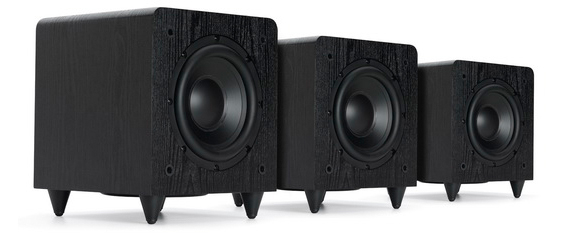Subwoofers produce the lowest frequencies, the bass, in most home theater audio systems. Whether it is the boom from a bass drum or the room-shaking explosion in an action adventure movie, subwoofers provide the foundation for a great sound system.
Hiding in Plain Sight
Traditionally subwoofers were usually a square box, often quite large and placed on the edge of one of the room’s walls. If a big box doesn’t fit into your plans, you can now have a great performing sub that is hidden in a wall, ceiling or floor. These subwoofers are installed between the floor, ceiling joists or in-between the wall studs and they often have a grill that can be painted the same color as the room.
With other hidden subwoofers only a port is exposed in the room and this port can sometimes be disguised as a heating vent. Now you can have big bass without a big box in the room.
Big Things Come in Small Packages
Instead of hiding the subwoofer, many companies make small subwoofers. To understand how this is possible, a little background is needed. Most loudspeakers, including subwoofers, produce sound by a speaker cone moving back and forth. This cone movement produces sound waves in the room. Bass notes are very long sound waves and the traditional way to make these low notes was to use a large speaker with a big speaker cone. A large subwoofer might have a cone that is twelve inches in diameter or more. However, nowadays many manufacturers make subwoofers with much smaller speakers that compensate by moving the smaller cone back and forth farther. Some of these smaller subs can produce tremendous base given their smaller size and footprint.
What to Look For
Many subwoofers come with a microphone. When the system is being set up, the microphone is plugged into the subwoofer and placed in the seating area. The sub is then put into its installation or calibration mode to produce a variety of low notes. The microphone ‘hears’ these notes and automatically optimizes the sub for both the room and subwoofer’s placement in the room.
No matter what type of subwoofer you are considering, at the end of the day the subwoofer’s job is to produce loud low notes. Remember, loudness is measured in decibels (dB), so a subwoofer with a larger dB number can produce louder bass.
To produce bass that you not only hear, but you can also feel, the subwoofer must produce very low notes. The frequency of a note is measured in hertz (Hz), and a subwoofer with a smaller Hz number on the spec sheet can therefore reproduce deeper bass.
More Than a Numbers Game
But don’t buy a subwoofer just on the ‘numbers.’ There are two primary problems in buying just on the specifications. First, different manufacturers use different methods to measure their products and this makes comparing subwoofers by specification from more than one manufacturer very difficult. Secondly, specs don’t tell the entire story. The ultimate test is listening how accurately the subwoofer makes music or special effects in movies sound natural.
Our installers have years of experience in selecting subwoofers. We will take into consideration many other factors that affect performance such as room-size specifications, spacing options to place a subwoofer, existing amplification equipment and your primary types of entertainment content. Taking these key factors into consideration, along with our expertise in today’s technology, this will help us provide the perfect subwoofer system for you and your room.

